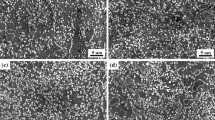Conclusions
The higher secondary case hardness of steels tempered in the austenitic condition can be explained by the formation of more highly dispersed carbides during tempering due to the lower diffusion mobility of elements in austenite as compared with α phase during the first tempering cycles and the smaller phase strain hardening of the matrix during subsequent tempering cycles, as well as the difference in composition and consequently the tendency of the carbide particles precipitated from austenite and martensite to coalesce.
Similar content being viewed by others
Literature cited
G. P. Alekseeva et al., "Heat resistant carburizing steel 13Kh3NVM2FA," Vestnik Mashinostroeniya, 7, 45 (1973).
V. N. Gridnev and Yu. N. Petrov, "Fine structure of martensite in carbon steels," Metal, i Term. Obrabotka Metal., 8, 29 (1967).
P. Shewmon, Diffusion in Solids [Russian translation], Metallurgiya, Moscow (1966), p. 137.
M. V. Belous, V. G. Cherepin, and M. A. Vasil'ev, Transformations during Tempering of Steels [in Russian], Metallurgiya, Moscow, (1973), pp. 120, 144.
Additional information
V. Ya. Chubar' Zaporozh'e Machine Construction Institute. Kherson Technological Institute. Translated from Metallovedenie i Termicheskaya Obrabotka Metallov, No. 7, pp. 62–63, July, 1975.
Rights and permissions
About this article
Cite this article
Banas, I.P., Lazechnyi, I.N., Natapov, B.S. et al. Characteristics of secondary hardening of carburizing steels. Met Sci Heat Treat 17, 613–614 (1975). https://doi.org/10.1007/BF00680415
Issue Date:
DOI: https://doi.org/10.1007/BF00680415




